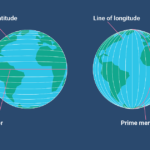One of the primary factors affecting the unequal heating of the Earth’s atmosphere is latitude. Latitude is the measurement of the distance of a location on the Earth from the equator. The further away from the equator that a location resides, the less sunlight that this location receives.
Latitude Effects Temperature
Why do location at higher latitudes receive less sunlight?
It all has to do with the shape of the Earth. Because the Earth is round, only the front most portion receives direct sunlight. If we pretend that the Earth is a man with a fat round tummy, it is easier to understand why this is the case. Suppose that the man falls asleep in the grass after enjoying reading a book. As he sleeps, a colony of ants climbs onto his stomach. Some of the ants are on the very top of his belly, while others are on either side.
The ants crawling on the top of the man’s stomach are in the direct light of the Sun. The further down the ants climb on either side, the less sunlight there is that can reach the ants. The sunlight becomes more and more spread out.
Now, let’s consider another example. This time, instead of light, we will consider shadows. If you go into a dark room and hold a flash light directly behind your hand what will you see? You should see a dark shadow cast on the floor or wall. Now what happens as you move the flashlight up and down with respect to your hand? Your hand’s shadow should become larger and smaller. Notice that the larger your shadow becomes the lighter it becomes, while a shadow cast by light that is directly behind your hand is darker.
The same is true with the light and energy from our Sun. The more direct the light is, the more intense it is, while less direct light is less intense. The angle at which light strikes the surface of the Earth is known as the angle of incidence.
Day Length Affects Temperature
Another important factor that has a direct impact on the heating of the Earth is the length of a day. The longer that a day lasts, the more time that there is for Earth to absorb energy from the Sun. Thus, longer days typically result in warmer days, while shorter days result in cooler days.
On the equator, the length of days changes very little throughout the year. Daylight shines for almost exactly 12 hours, and darkness reigns for almost exactly 12 hours. The further away that one travels from the equator, however, the more variation in length of day that will be observed.
In the summer days stretch out, becoming much longer than the nights, while the opposite is true in the winter, when night lasts longer than day.
Atmospheric Obstructions Affect Temperature
In earlier chapters we have discussed the many particulates that exist in our atmosphere. Tiny particles of dust, water vapor, pollen, animal hair, and microscopic life absorb, scatter, and alter the Sun’s energy before it can reach the Earth’s surface. Increasing the levels of these particulates blocks more of the Sun’s energy from reaching the surface, causing a decrease in temperature. One way that particulates are increased is via cloud cover. The clouds block the heat and light from the Sun, making for a cooler day.
Land and Water Affect Temperature
The atmosphere of the Earth is primarily heated by radiation coming off of the Earth. 50% of the Sun’s energy is absorbed by the Earth and then released back into the atmosphere. Thus, the temperature of the air in a given location can be greatly affected by the materials found on the surface.
Some materials absorb more energy, while other materials reflect more energy. Organic materials such as plants and animals tend to absorb more energy than do barren deserts. Thus, the air temperature in a forest is usually cooler than the temperature in a desert. Likewise, the blacktop, rooftops and buildings of a city act like a desert, raising the temperature of an area by as much as 10 degrees.
Water absorbs vast amounts of energy from the Sun. Likewise, bodies of water release energy very slowly. For this reason, areas near water are usually more mild.
Because of water’s ability to absorb heat, store it and release it later, the oceans of the Earth have an important role in helping to moderate the Earth’s temperature.






